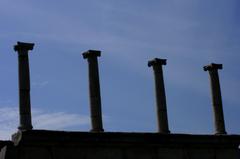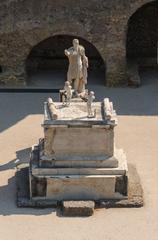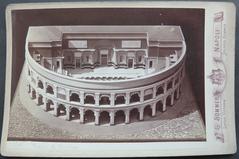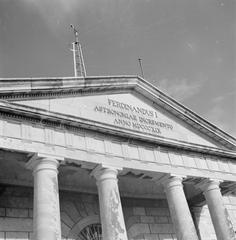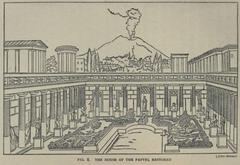Comprehensive Guide to Viale degli Ippocastani in Herculaneum, Italy
Date: 18/07/2024
Introduction
Table of Contents
- Introduction
- Background Information of Viale degli Ippocastani
- Visitor Information
- Special Events and Guided Tours
- Photographic Spots
- FAQ
- Conclusion
- Sources
Background Information of Viale degli Ippocastani
A Post-Excavation Creation
Unlike many ancient Roman streets, Viale degli Ippocastani was created during the archaeological excavations of Herculaneum, serving as a boundary between the unearthed ancient city and the modern town.
Separating Past and Present
The avenue acts as a tangible line between two worlds - the bustling modern town of Ercolano and the preserved ruins of Herculaneum. Walking along Viale degli Ippocastani allows visitors to observe this stark contrast.
Named for its Trees
True to its name, Viale degli Ippocastani is lined with horse chestnut trees, providing a shaded and picturesque walkway for visitors.
A Gateway to Ancient Herculaneum
Viale degli Ippocastani serves as the main entry point for visitors to the Herculaneum archaeological site, building anticipation as one strolls towards the entrance.
More Than Just a Street
Viale degli Ippocastani is an integral part of the Herculaneum experience, setting the stage and providing context as visitors transition from the modern world to the ancient Roman city.
Visitor Information
Visiting Hours and Tickets
Viale degli Ippocastani is accessible during the same hours as the Herculaneum archaeological site. Tickets can be purchased at the entrance or online through the official Herculaneum website.
Travel Tips
To reach Viale degli Ippocastani, take the Circumvesuviana train to Ercolano station and follow the signs to the archaeological site. The best times to visit are early morning or late afternoon to avoid the midday heat and crowds.
Nearby Attractions
Nearby attractions include the Herculaneum Museum, Villa Campolieto, and the MAV Virtual Archaeological Museum.
Accessibility
Viale degli Ippocastani is wheelchair accessible, with ramps and pathways designed to accommodate visitors with disabilities.
Special Events and Guided Tours
Special events, including historical reenactments and cultural festivals, are held throughout the year. Guided tours are available and can be booked in advance for a more in-depth experience.
Photographic Spots
The best spots for photography along Viale degli Ippocastani include the tree-lined walkway, the view of the ancient ruins from the avenue, and the entrance to the archaeological site.
FAQ
- What are the visiting hours for Viale degli Ippocastani? Visiting hours are aligned with the Herculaneum archaeological site, typically from 8:30 AM to 7:30 PM.
- How can I purchase tickets for the Herculaneum archaeological site? Tickets can be purchased at the entrance or online via the official Herculaneum website.
Conclusion
Viale degli Ippocastani is not just a passageway but an integral part of the Herculaneum experience. Plan your visit today to explore this unique avenue.
Call to Action
For more information, download the Audiala mobile app, check out other related posts, and follow us on social media for the latest updates.
Exploring Viale degli Ippocastani - History, Tickets, and Visiting Hours
Introduction
Viale degli Ippocastani, or “Avenue of the Horse Chestnuts,” is more than just a picturesque street in Herculaneum; it is a vital link to the grandeur and tragedy of this ancient Roman town. From its significance in Roman urban planning to its preservation under volcanic ash, this avenue offers a unique and compelling journey through history. This guide will provide comprehensive information, including visiting hours, ticket prices, and travel tips to enhance your visit.
A Window into Roman Urban Planning
The avenue’s very existence speaks volumes about Roman urban planning. Viale degli Ippocastani follows the course of an ancient Roman road that once formed the main thoroughfare of Herculaneum. This road, known in Roman times as the Cardo Maximus, was the primary north-south artery of the town, connecting the forum and other important public buildings. Its wide path, designed to accommodate carts and pedestrians, reflects the bustling life that once characterized Herculaneum.
The Eruption’s Impact - From Bustling Avenue to Buried Time Capsule
The eruption of Mount Vesuvius in 79 AD tragically interrupted life in Herculaneum, burying the town, including Viale degli Ippocastani, under meters of volcanic material. This catastrophic event, while devastating, also served as an accidental preservative. The layers of ash and mud effectively froze the avenue in time, providing a remarkably well-preserved snapshot of Roman life.
Architectural Treasures Unveiled
Excavations of Viale degli Ippocastani have unearthed a wealth of architectural treasures, offering invaluable insights into the daily lives of Herculaneum’s inhabitants. Some of the most notable discoveries include:
- The House of the Mosaic Atrium: This grand domus, or Roman house, boasts a stunning mosaic floor in its atrium, showcasing the artistry and craftsmanship of the era.
- The House of the Wooden Partition: This structure provides a fascinating example of adaptive architecture. Originally a single dwelling, it was later divided into multiple shops, reflecting the evolving needs of the community.
- Thermopolia: These ancient Roman fast-food restaurants, with their characteristic marble counters embedded with terracotta pots, offer a glimpse into the culinary habits of the time.
The Horse Chestnut Connection - A Modern Addition
While the avenue’s Roman name remains unknown, its modern moniker, Viale degli Ippocastani, or “Avenue of the Horse Chestnuts,” speaks to a later chapter in its history. The avenue is lined with horse chestnut trees, planted long after the town’s rediscovery. These trees, with their spreading canopies and seasonal blooms, add a touch of verdant beauty to the ancient setting, creating a poignant contrast between the past and present.
Visitor Information
Visiting Hours: Viale degli Ippocastani is open to visitors from 8:30 AM to 7:30 PM daily. Please check the official website for any changes in hours or special events.
Tickets: Tickets for Viale degli Ippocastani can be purchased at the entrance or online. Prices range from €11 for adults to €5.50 for children and seniors. It is recommended to book in advance to avoid long queues.
Travel Tips
To make the most of your visit to Viale degli Ippocastani, consider the following tips:
- Wear comfortable shoes: The ancient cobblestones can be uneven, so sturdy footwear is essential.
- Bring water: Especially during the summer months, staying hydrated is crucial.
- Visit early: Arriving early in the morning can help you avoid the midday crowds and heat.
Nearby Attractions
While in Herculaneum, don’t miss other historical sites such as the Herculaneum Archaeological Park, the Suburban Baths, and the Villa of the Papyri. Each offers a unique glimpse into Roman life and complements your visit to Viale degli Ippocastani.
Accessibility
Viale degli Ippocastani is partially accessible to visitors with disabilities. However, some areas may be challenging to navigate due to the ancient terrain. It is advisable to check the official website for detailed accessibility information.
A Walk Through Time
Today, strolling along Viale degli Ippocastani is akin to taking a step back in time. The unearthed cobblestones, the remnants of shops and houses, and the looming presence of Mount Vesuvius in the distance all serve as tangible reminders of the town’s vibrant past and its sudden demise.
FAQ Section
- What are the visiting hours for Viale degli Ippocastani? Viale degli Ippocastani is open from 8:30 AM to 7:30 PM daily. Check the official website for any updates.
- How much are tickets to visit Viale degli Ippocastani? Tickets range from €11 for adults to €5.50 for children and seniors. Online booking is recommended.
- Are there guided tours available? Yes, guided tours are available and can be booked in advance through the official website.
Conclusion
Exploring Viale degli Ippocastani offers an unparalleled journey through history. From its roots in Roman urban planning to its preservation under volcanic ash, this avenue is a must-visit for history enthusiasts. Don’t forget to check out nearby attractions and plan your visit to make the most of this extraordinary experience.
Call to Action
For more information, download the Audiala mobile app, check out other related posts, and follow us on social media for the latest updates.
